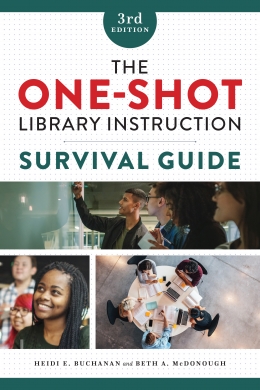Primary tabs
You don't need to be an ALA Member to purchase from the ALA Store, but you'll be asked to create an online account/profile during the checkout to proceed. This Web Account is for both Members and non-Members.
If you are Tax-Exempt, please verify that your account is currently set up as exempt before placing your order, as our new fulfillment center will need current documentation. Learn how to verify here.
- Description
- Table of Contents
- About the authors
- Reviews
Previously named by Library Journal “a terrific resource for instruction librarians at all experience levels,” the updated third edition will foster students’ critical thinking skills while empowering librarians to become better, more confident teachers.
When done well, one-shot library instruction allows you to build solid relationships with faculty while also making positive first impressions with students. Good pedagogy, collaboration with faculty, assessment, and reflection are all imminently possible in the one-shot. So is incorporating the big ideas of the ACRL Framework. This new edition of a trusted resource will guide you in active, student-centered one-shots that connect to courses’ learning outcomes. Demonstrated using vignettes that share teaching experiences drawn from librarians and instructors in the field, you’ll get succinct, hands-on advice on such topics as
- why threshold concepts are well suited to one-shot instruction;
- online instruction-specific engagement strategies and talking points;
- a one-shot version of curriculum mapping to help you prioritize;
- quick and easy activities to work into sessions;
- how to mix and match the three types of instruction best suited to one-shots;
- losing the list, ditching the script, and other strategies for student-centered teaching;
- common classroom management mishaps and what to do about them;
- talking points for the instruction interview;
- how and when to say no; and
- 5 ways to use assessment to improve your instructional style.
Acknowledgments
Chapter 1 “They Never Told Me This in Library School”
Chapter 2 “The Teaching Faculty Won't/Don't __________”: Communicating and Collaborating with Instructors
Chapter 3 “How Will I Cover Everything?”
Chapter 4 “How Do I Get Them to Pay Attention?”: Classroom Strategies for One-Shot Instruction
Chapter 5 “My Classroom Is [Online, in an Auditorium, with No Computers, during a Global Pandemic]”
Chapter 6 “How Will I Know What Worked?”
Chapter 7 “There’s Not Enough of Me to Go Around!”: What to Do When You Become a Victim of Your Own Success
Glossary
Bibliography
Index
Heidi E. Buchanan
Heidi E. Buchanan is a research and instruction librarian and professor at Hunter Library, Western Carolina University, where she also serves as information literacy instruction coordinator. Her MSLS is from the University of North Carolina, Chapel Hill. She is a graduate of the ACRL Information Literacy Immersion Program and a certified North Carolina Master Trainer.
Beth A. McDonough
Dr. Beth A. McDonough is a research and instruction librarian and associate professor at Hunter Library, Western Carolina University. Her MLS is from the University of North Carolina at Greensboro. Beth earned an Ed.D. in leadership of curriculum and instruction at Western Carolina University in 2014. Her dissertation focused on critical information literacy.
“A concise and useful handbook for the creation of successful information literacy instruction sessions.”
— College & Research Libraries
Praise for the previous editions
”Concise, up-to-date ... A terrific resource for instruction librarians at all experience levels."
— Library Journal
“The book covers practical ideas on using the six frames, inspired solutions for difficult assignments, vignettes from actual librarians in the field, assessment techniques, and suggestions for how to make information literacy relevant to students ... [it] will inspire instruction librarians to move beyond traditional bibliographic instruction, such as 'click here, go there' demonstrations of library resources, to more engaging information literacy instruction sessions.”
— Reference & User Services Quarterly
“Filled from cover to cover with strategies to guide students utilizing library resources.”
— Library Bookwatch



